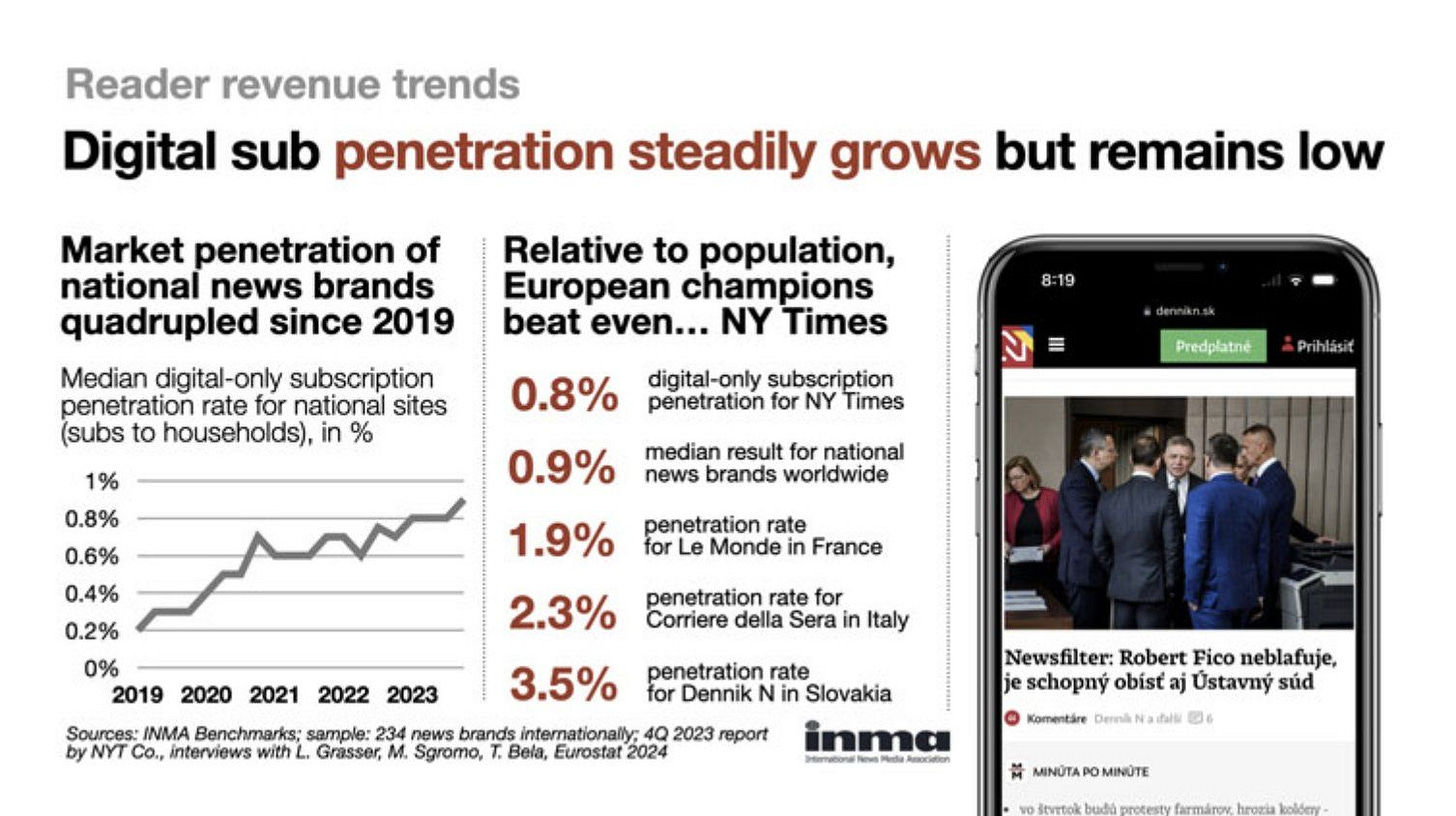Welcome to the Youthquake and stuff newsletter
Because we can't just slack all these links back and forth between the two of us anymore.
Youthquake and Stuff is your bi-weekly dose of the latest trends, practical strategies, and straight talk on connecting with the younger crowd, curated by media industry geeks Liesbeth Nizet and Danuta Breguła. We genuinely believe news publishers can win over the youth. However, to make that happen, we've got to shake things up a bit. You can learn more about the reports we publish here.
Welcome! Lies and Dana here! In today’s post, we’ll talk a bit about publishers’ perspectives for audience and subs growth, what is happening with boys, where the future of the competition of content creators and media brands could be heading and other stuff that we giggle or worry about recently. We won't discuss the TikTok ban, as there are still too many unknowns and numerous explainers available everywhere. Instead, you can take a look at how content creators are preparing for it.
But first, let us share one thing:
Why Youthquake? What does it even mean?
Youthquake emerged as a cultural phenomenon in the 1960s, fueled by music, pop culture, and a seismic shift in fashion. The term was coined by Vogue magazine's editor-in-chief Diana Vreeland in 1965, it marked a departure from traditional norms, with youth culture driving trends and challenging the dominance of English and Parisian couture houses (wiki).
In December 2017, OxfordDictionaries.com crowned 'youthquake' as the word of the year, reflecting its widespread usage, particularly in discussions surrounding young people's political engagement. Many credited the term with capturing the leftward swing in the youth vote during that time.
To us, though, trends aren't exclusive to the youth. The youth rather serve as trailblazers, spotting and embracing new movements before they permeate through older generations. The young crowd serve us cultural beacons- they are the first ones to spot them and adopt them in their daily lives, making older generations follow.

[BUSINESS]
Have We Hit the Subscription Ceiling? What's the Scoop on Getting Youth to Subscribe?
Gen Z is making waves in the market, particularly in how they subscribe to digital content, leading the pack over other age groups. Their openness to advertising and strong interest in gaming are key trends, especially as platforms like Netflix start to explore gaming, highlighting significant growth opportunities for subscriber numbers and revenues. Gen Z also shows a clear preference for a unified platform to manage their streaming subscriptions and is calling for improved user experiences.
Turning to the publishing industry, there's much to consider. The idea of creating a single access point for digital subscriptions aligns with Gen Z's desire to streamline their online experiences, avoiding the hassle of managing multiple subscriptions. They're also the top spenders on digital content, willing to invest $75-100, yet 40% feel that the cost increases are not matched by better streaming experiences, pointing to a demand for better value.
The publishing sector is facing its own set of challenges and adjustments. With terms like 'the great news subscription reversal' coined by Axios, there's a trend among U.S. publishers to reassess subscription strategies in light of declining subscriber numbers. Companies like TechCrunch and The Washington Post are exploring new approaches, moving towards investor-focused content and dynamic pricing models, respectively. Meanwhile, Time and Quartz are pivoting towards ad-supported and membership models, showing a shift away from strict paywalls.
However, in Europe, the outlook appears more positive, with some publishers experiencing success and market penetration rates that rival those of The New York Times when adjusted for population size.
What does it mean for you? Integrate gaming and interaction: Capture Gen Z's interest with gamified content and interactive storytelling, making subscriptions more engaging.
Create a unified platform: Offer a one-stop subscription management platform for all digital content, catering Gen Z’s desire for simplicity.
Remember that young people are comparison-consumers. According to Recurly’s survey, free trials are not enough (65% of Gen Z respondents say they would be more more likely to subscribe if a free trial is offered, while for Boomers it would be convincing for 82%). Also, 61% of people age 58-68 are more likely to feel like a valued subscriber if they are rewarded (e.g., discounts, free items) but only 37% of Gen Z would agree. They pay attention to other product features than older generations. They are much less likely to come to your sites or apps intentionally even if subscribing. Their loyalty is conditional and they have adopted subscription-hopping. News subs are first to cancel when crisis comes.
Consider dynamic pricing: Adopt dynamic pricing and add value with exclusive content or perks, making subscriptions more personalized and valuable.
[SOCIETY]
What is happening with boys
Through our work with media brands, we try hard to avoid generalizations. Surely, you've noticed how confusing it gets when most reports suggest that Gen Z is hyper-progressive on certain issues but surprisingly conservative on others. This piece from the FT brings up the studies of Alice Evans, a visiting fellow at Stanford University, that suggest what we are observing is "a great gender divergence." “Gen Z is two generations, not one” and. one of the most urgent challenges gripping societies seems to be the shift in how boys and young men see the world, what are their behavioral patterns (think voting preferences), how they feel, and why this is everybody’s business. The mental health emergency among the youth and how media brands can at least try to stop contributing to it is our core interest and one of the reasons we continue our research. Here are recent stories that add to the bigger picture this week:
The results of the study by King’s College London’s Policy Institute and Global Institute for Women’s Leadership, in partnership with Ipsos, tell us more about how young men and women perceive their chances to prosper in life depending on their sex. Yes, they are also asked about Andrew Tate and toxic masculinity (and whether this term is actually helpful or quite the opposite).
This voice of a progressive parent bringing up young sons.
Ipsos’ annual International Women’s Day survey finds 60% of Gen Z men across 31 countries think women’s equality discriminates against men.
What staggered us this week was this absolutely horrific story covered by Wired, Der Spiegel and Recorder.
This excellent essay by Christine Emba titled “Men are lost. Here’s a map out of the wilderness” gives us some solutions.
Not a competition but still a competition. What’s next?
This take on the made-up trends (aka trendbait) and made up words from Vox is so on point, however, sometimes these neologisms strike a chord. Take jinfluencers: one of our favorites is French Gen Z content creator mega star Hugo Travers, who made headlines for interviewing President Macron on YT and streaming it live last autumn (checkout his interview on the occasion of being named one of French GQ’s men of the year), just interviewed Zendaya and Timothy Chalamet. This exemplifies how to master the balance between entertainment and substance, strengthening your platform and credibility across different domains. Plenty of reliable, solid and extremely engaging journalism is available on social platforms. Journalists, creators-educators, commentators develop their strategies and become powerful voices of their generation. They are not going anywhere. Furthermore, they're beginning to recognize that we're part of a larger ecosystem, and the way forward isn't to replace traditional journalism but to find a way for both to coexist, each excelling in their respective strengths and eventually sharing revenue.
I’ve always said this, but independent journalists/ commentators/ content creators (like me! I’m self-aware) RELY on the work of others to do their jobs. None of those TikTokers, Instagram pages, YouTube channels, podcasters newsletter writers who give you all your linky-links - whoever it is that you love - would be able to make things make sense for you without someone on the ground reporting it first, and being paid to do so by the legacy outlets that are meant to protect them. We shouldn’t be getting all our news from 10 Instagram slides or 60-second videos on TikTok - and we know this. (from Shit you should care about’s recent post)

Report we enjoyed this week
FT Strategies conducted an extensive study on the future of news consumption in 2030, drawing insights from young crowds in the US, Nigeria, and India. We love the global perspective and clear directions presented in the report that you can download here.
This gives us good vibesSome time ago, we compiled a set of key takeaways for publishers looking to capitalize on the insights gleaned from the BookTok phenomenon. Follow up: we are particularly moved by a recent piece from Refinery29.
And this week’s Embedded post about a chronically online Tik Tok accent actually made us giggle.
Some news start-ups seemed to have learned from predecessors like Buzzfeed by taking the opposite direction, offering all of us some sprouts of hope in the media landscape.
Do not miss
Sophia Smith Galer’s Shortform Storytelling: Creating Impactful TikToks and Reels course on Skillshare. Sophia is a multi-award-winning journalist, author and content creator with more than 160 million views on TikTok and Instagram and we often mention her work in our talks.
Something for the aesthetic junkies out there.
Liesbeth’s webinar about subscription pricing fundamentals for publishers on March 27th.
That’s it for today!
Best
Dana & Lies
P.S. We would love to hear your thoughts!
Want more?
Download our recent “How publishers can grow with today’s youth. Navigating engagement and monetization” report.
Follow Liesbeth Nizet on LinkedIn
Follow Danuta Breguła on LinkedIn











